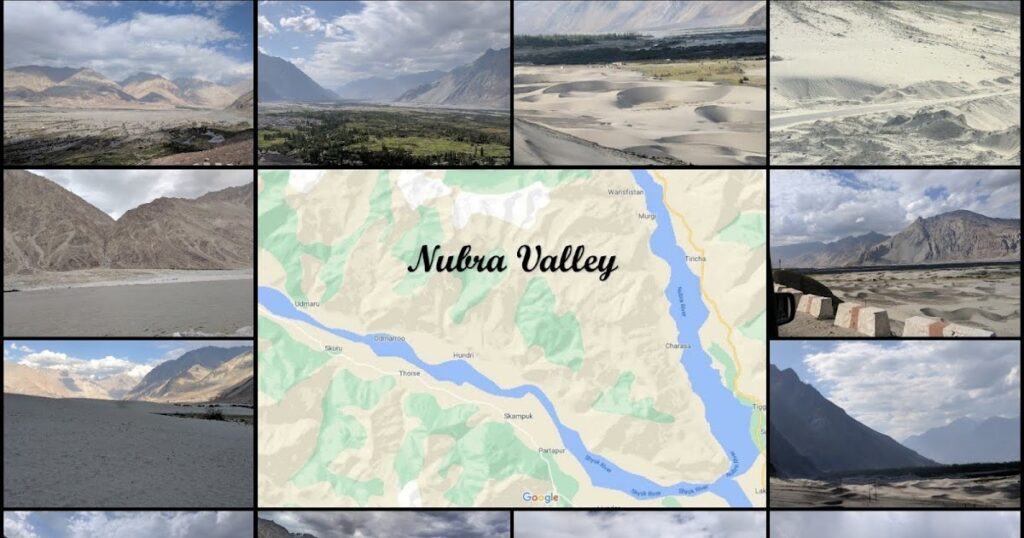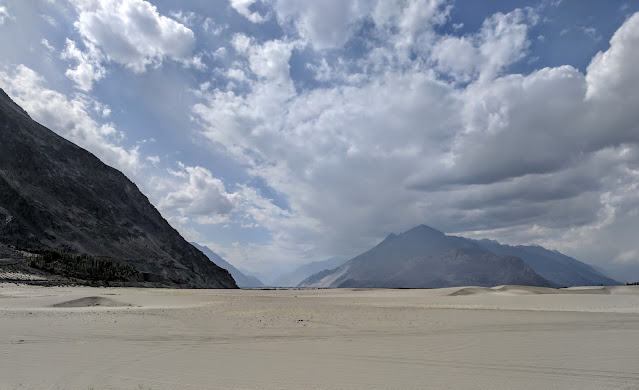The Nubra
region lies north of Leh, two scenic valleys formed by the Nubra and Shyok
rivers, between the Ladakh range and the Karakoram mountains. The region is
part green, part rocky and barren, and part desert, sand dunes and all. This
was our destination for the next couple of days of our Ladakh tour.
 |
| Mountains, rivers, trees and sand, together at 10,000 ft! |
Setting off
quite early in the morning, we had our first experience of what a traffic jam
looked like here! We found ourselves in a line of vehicles behind a convoy of
army trucks, and it was slow going, allowing us to not only enjoy the
landscape, but also appreciate the difficulties the terrain posed to the army,
and the efforts that must go in to maintaining these roads.
The
KhardungLa pass, said to be the world’s highest at 5,602m (18,380ft), was
filled with tourists clicking away. We halted for a while at the insistence of
our driver, but moved on as quickly as possible!
We also
visited the monastery at Sumur en route, at our driver’s suggestion. This
monastery appears to be relatively new or newly renovated, but very similar to
the other monasteries we had visited, in terms of paintings and images. The
location, on the banks of the Nubra river, close to where the Nubra and Shyok
rivers merge, is the highlight of the monastery.
 |
| Monastery at Sumur |
 |
| View of the Nubra river from the monastery |
Had I known
better, I would have skipped this monastery to visit the one not too far away
at Diskit, which dates to the 15th century. We realized this as we
passed Diskit on our way to Hunder, which was our destination for the day. We
did not have time to halt at Diskit, which would have taken up the rest of our
day.
 |
| Monastery at Diskit |
Instead, we made a short halt at a 105ft tall statue of Maitreya Buddha
that has recently been installed here. Among the
huge images we had seen so far, this was the one I liked the least. First of
all, it felt out of place, built for decoration, not for worship. The garish
colours added to this, and I thought of this statue, out in the snow in winter,
and wondered what it was like, then. My favourite was the one at Shey, of
course, but the Maitreya at Thiksey was so beautiful and serene. This
particular one, in my opinion, stood out only by size.
 |
| Maitreya Buddha at Diskit |
Once we
passed Diskit, the sand dunes began to appear. Till then, we had seen sand, but
not dunes like these….
There is no
way I can do justice to the sight with words, but here, let me quote a section
from my diary… with my photos, you will hopefully be able to get a more visual
idea of our experience.
It has
been a day of stunning landscapes once again. From KhardungLa to the Nubra
valley, the ever-changing landscape had me exclaiming all the time! From the
sheer rock to the sand dunes, it has been unbelievable.
The sand
dunes of Nubra are spread over a small area, and they share space with streams
and greenery, which, for lack of better adjectives, is yes, stunning and
unbelievable. It is a desert, but it is so much more! This juxtaposition of
high altitude (the average elevation here is about 3,000m or 10,000ft), and
cold desert, along with rivers flowing down from glaciers (the Nubra is a
tributary of the Shyok river, which originates in the glaciers of Siachen) is
certainly unique.
The
Bactrian camels, however, are over-hyped, since they are here only for the
tourists. They might have lived here in some bygone times, but certainly don’t
now. The place is filled with tourists either squealing while getting on to one
of the camels, or cooing as they pet them. We opted instead, to wander far from
the noisy hordes, and enjoy the landscape in whatever solitude was possible.
We stayed
the night at a guest house at Hunder. The original plan had been to relax and
enjoy more of the sand dunes the next morning before heading back to Leh.
However, one sight of the crowd changed our mind and we modified our plans
based on conversations with people we met. More about that later, but for now,
here’s another entry from my diary –
Today
might have been a day of stunning landscapes, but the highlight was, however,
giving a lift to a Russian tourist, named Nikolai. Why am I talking about this?
Because he was unlike any tourist we had ever met, and deserves a mention. We
saw him as we left KhardungLa, by the side of the road, trying to hitchhike.
There were others like him, most of them young. He stood out not only because
he was middle aged, but because he was on crutches! Turns out that he suffers
from a form of arthritis, and is in India for ayurvedic treatment. Apart from
the fact that the man was travelling alone, to highest pass in the world, on
crutches, the coming to India for treatment didn’t seem odd, but his story made
it so much more interesting. Apparently, he had first visited India 8 years
earlier, and made an Indian friend. Then, 6 years back, he developed arthritis,
and was bed-ridden. He had been in touch with his old friend from India, who,
hearing of his situation, turned up in Moscow, helped him cope, and eventually
convinced him to try ayurvedic treatment, bringing him back to India. Nikolai
had been in India for 6 months when we met him, and in this period, had
improved to the extent of exploring the country on crutches, using public
transport when possible, hitchhiking otherwise, on a shoestring budget. He is a
photographer, and his camera was the only valuable thing he had on him. We
dropped him off at Hunder village, hoping he had found some affordable accommodation.
We saw him the next afternoon, on our way back to Leh. He was waiting for
someone else to give him a lift in the opposite direction.
We meet
many such people on our travels, but we rarely manage to stay in touch. We are,
as they say, ‘ships passing in the night’. But every such meeting, I believe,
changes is in some way, or leaves a lasting impression on us. Nikolai did too.
We often talk of travel as something that can only be done by the fit. I myself
hesitate to strain myself, knowing my limitations, and when it comes to older
people or people with disabilities, we often discourage them from exploring,
especially on their own. But our encounter at Nikolai showed me that anything
is possible, if only we have the will.
P.S.
Shankar, on reading this, adds – I wonder what our experience would be, if we
ever went solo travelling, in Russia!













